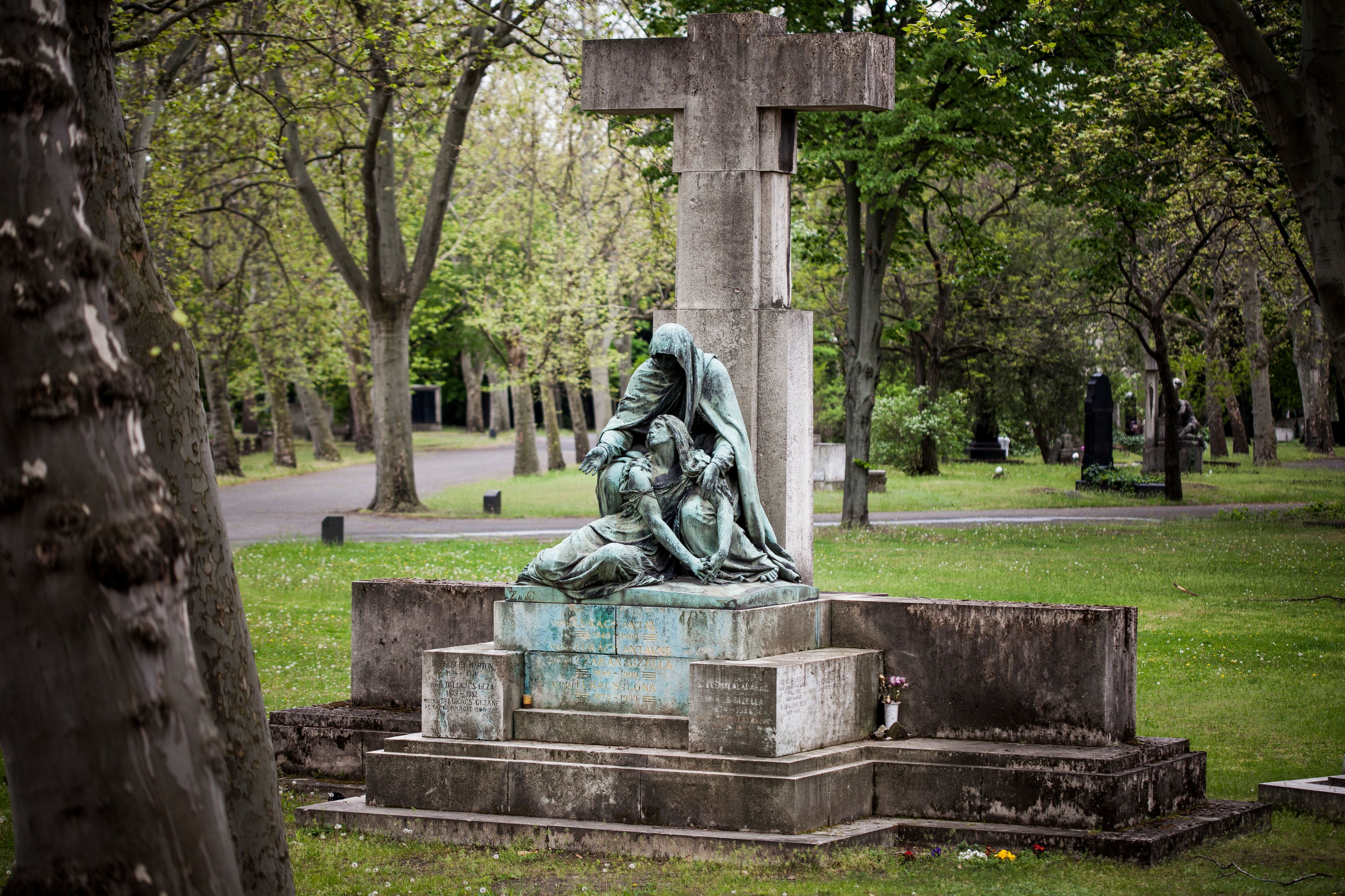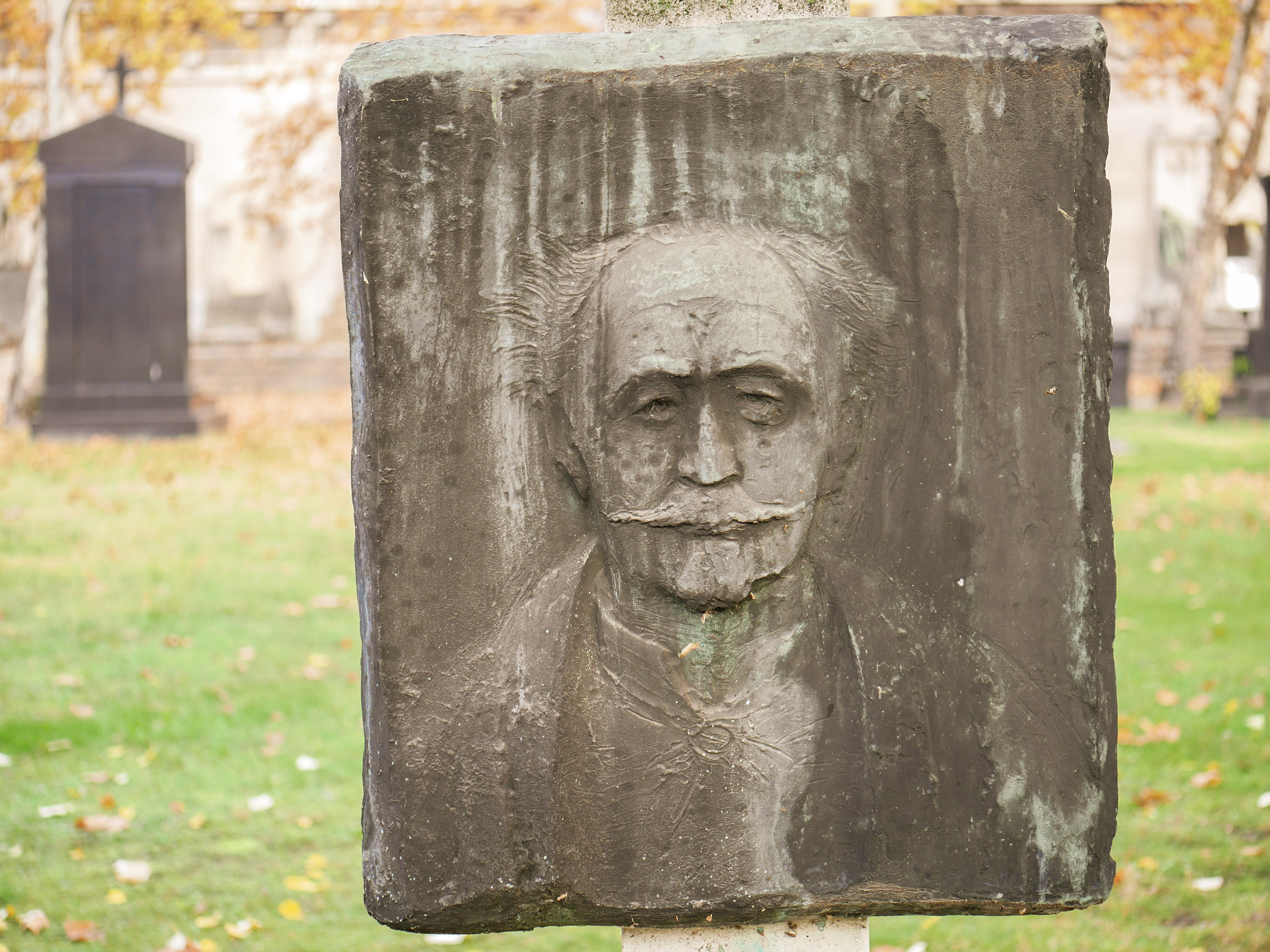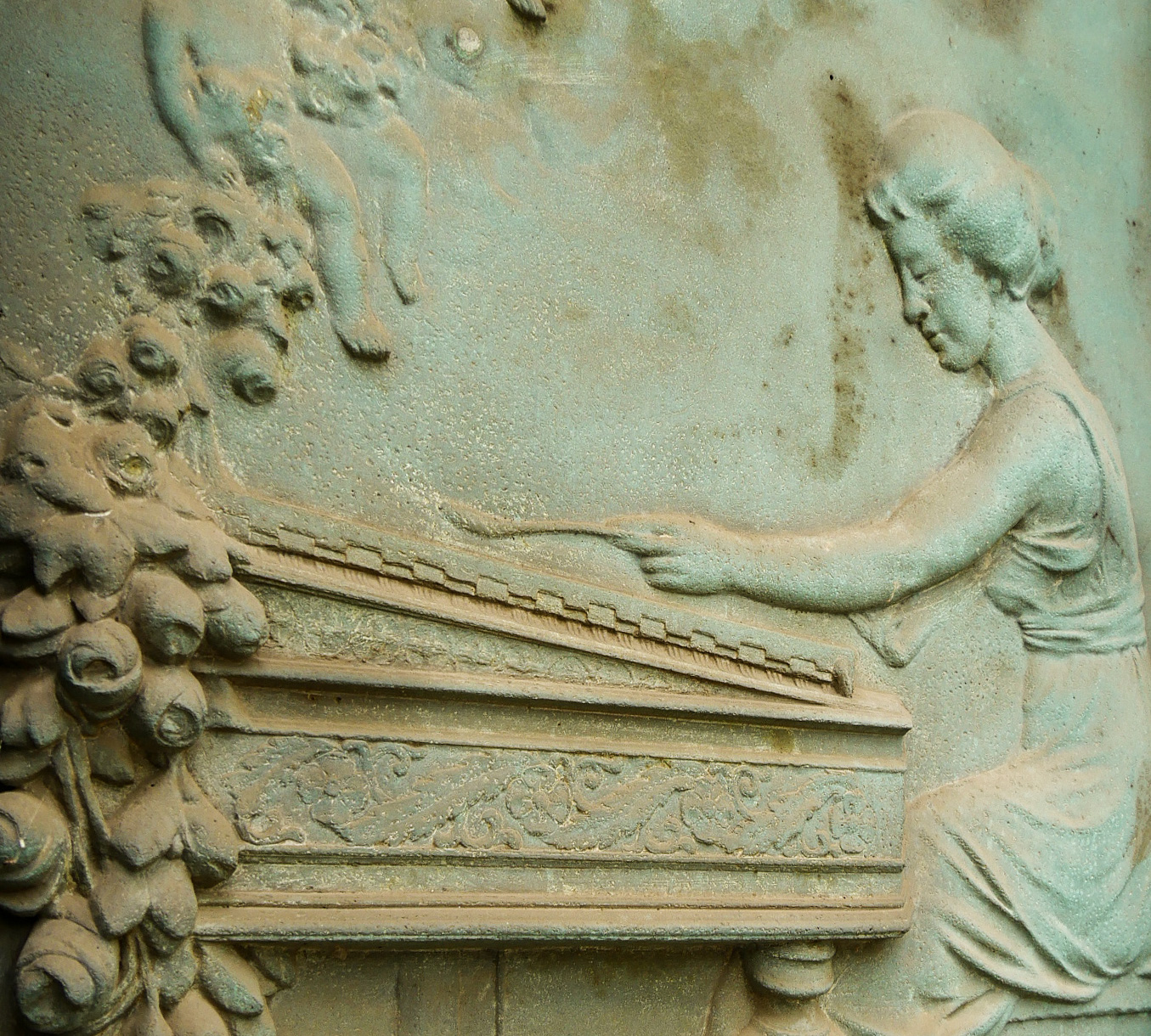
19. parcella
Mária és Magdolna, Lukács Antal síremléke, bronz, 1884 (19-1-1)
Szobrász: Zala György
Az 1884-ben faragott Mária és Magdolna márványcsoport Zala György első klasszikus alkotásának tekinthető, aki ekkor még Münchenben tanulmányi éveit töltötte. Ezzel a szobrával az ifjú művész elnyerte a Képzőművészeti Társulat művészeti nagydíját. A mű komoly sikerét az is jelzi, hogy ennek a korai munkájának köszönhetően országos ismertségre tett szert.
 Kétségtelen a kompozíciónak Michelangelo Pietájával való rokonsága, de a két szobor kifejezéstartalma eltér egymástól. A reneszánsz mester művén Mária fia holttestét tartja ölében, Zala kompozíciójában Krisztus alakja helyére Mária Magdolnáé kerül, aki a fájdalmas Szűz elé rogyva kétségbeesetten tördeli a kezét. Az anya fájdalmát átélő, de mégis vigasztalni tudó istenanya tartja a lelket a lábaihoz rogyó, zilált Magdolnában. Ez az ábrázolásmód teljesen új felfogást jelent a hagyományos Pieta-ábrázolásokhoz képest. Az isteni lényegű bűntelen Krisztust Zala György a közfelfogásban bűnös asszonynak titulált Magdolnával cseréli fel, ezáltal válik a legmélyebb fájdalmat átélő, fiát elvesztő Asszony az egész emberiség gondviselőjévé a gyász pillanataiban.
Kétségtelen a kompozíciónak Michelangelo Pietájával való rokonsága, de a két szobor kifejezéstartalma eltér egymástól. A reneszánsz mester művén Mária fia holttestét tartja ölében, Zala kompozíciójában Krisztus alakja helyére Mária Magdolnáé kerül, aki a fájdalmas Szűz elé rogyva kétségbeesetten tördeli a kezét. Az anya fájdalmát átélő, de mégis vigasztalni tudó istenanya tartja a lelket a lábaihoz rogyó, zilált Magdolnában. Ez az ábrázolásmód teljesen új felfogást jelent a hagyományos Pieta-ábrázolásokhoz képest. Az isteni lényegű bűntelen Krisztust Zala György a közfelfogásban bűnös asszonynak titulált Magdolnával cseréli fel, ezáltal válik a legmélyebb fájdalmat átélő, fiát elvesztő Asszony az egész emberiség gondviselőjévé a gyász pillanataiban.
Az eredeti márványalkotást a pécsi Püspöki Palota őrzi.
Madarász Viktor, bronz, márvány, 1967 (19-1-34)
Szobrász: Vigh Tamás
 A magyar történeti festészet egyik legjelentősebb alkotójának nyughelye évtizedeken keresztül jeltelen volt, a festőművész síremlékét Madarász Viktor halálának 50. évfordulójára emeltette a főváros. Annak ellenére, hogy a dualizmus korszakának megváltozott politikai hangulatában mellőzött művésszé vált Madarász, a temetésén mégis képviselte magát az akkori művészvilág színe-java. A festőművészt a Szépművészeti Múzeum előcsarnokában ravatalozták fel, amelyet a művész „Hunyadi László siratása“ című képének mintájára rendeztek be. A művész végakarata szerint sírjába rakták azt a kardját is, amellyel 1848-ban, mint honvédhadnagy harcolt a szabadságharcban. A síremlékén a sír kőlapjára állított, magasba nyúló karcsú márványoszlop, mint egy festőállvány helyezkedik el, amin a bronzból mintázott portrédombormű jelenti a vásznat. Az arcképet Vigh Tamás a festőművész 1910-ben festett, szembenéző önarcképe alapján formázta meg, amelyen a hegyes pödrött bajuszú, ritkásodó hajú, mellényt, kabátot és csokornyakkendőt viselő időskorú művész látható.
A magyar történeti festészet egyik legjelentősebb alkotójának nyughelye évtizedeken keresztül jeltelen volt, a festőművész síremlékét Madarász Viktor halálának 50. évfordulójára emeltette a főváros. Annak ellenére, hogy a dualizmus korszakának megváltozott politikai hangulatában mellőzött művésszé vált Madarász, a temetésén mégis képviselte magát az akkori művészvilág színe-java. A festőművészt a Szépművészeti Múzeum előcsarnokában ravatalozták fel, amelyet a művész „Hunyadi László siratása“ című képének mintájára rendeztek be. A művész végakarata szerint sírjába rakták azt a kardját is, amellyel 1848-ban, mint honvédhadnagy harcolt a szabadságharcban. A síremlékén a sír kőlapjára állított, magasba nyúló karcsú márványoszlop, mint egy festőállvány helyezkedik el, amin a bronzból mintázott portrédombormű jelenti a vásznat. Az arcképet Vigh Tamás a festőművész 1910-ben festett, szembenéző önarcképe alapján formázta meg, amelyen a hegyes pödrött bajuszú, ritkásodó hajú, mellényt, kabátot és csokornyakkendőt viselő időskorú művész látható.
Schunda Vencel József, bronz, 1912 (19-1-10)
Szobrász: Beck Ö. Fülöp
 A neves hangszergyáros 1911-ben elhunyt felesége emlékére készíttette a síremléket az akkor újonnan emeltetett kripta fölé, amelybe a korábban elhunyt családtagjait is áttemettette. A monumentális, klasszicista stílusú fekete gránit emléket a Gerenday Antal és Fia cég készítette, a plasztikai részletét Beck Ö. Fülöp szobrászművész.
A neves hangszergyáros 1911-ben elhunyt felesége emlékére készíttette a síremléket az akkor újonnan emeltetett kripta fölé, amelybe a korábban elhunyt családtagjait is áttemettette. A monumentális, klasszicista stílusú fekete gránit emléket a Gerenday Antal és Fia cég készítette, a plasztikai részletét Beck Ö. Fülöp szobrászművész.
A síremlék díszítményeként szolgáló domborművön a „magyar cimbalom”, vagyis egy pedálos cimbalom látható, ami Schunda V. József hangszerész bravúros találmánya volt 1874-ben. A gazdagon díszített hangszeren egy hosszúruhás nő játszik. A füzérben leomló rózsákból éneklő és muzsikáló puttók emelkednek a magasba, akik hegedűn, csellón és tárogatón kísérik a cimbalmozó nő játékát, megidézve az elhunyt, szeretett feleség emlékét.
Mary and Magdalene, tomb of Antal Lukács, bronze, 1884 (19-1-1)
Sculptor: György Zala
The marble Mary and Magdalene composition carved in 1884 can be viewed as György Zala’s first classical piece. At the time he was still studying in Munich. The young artist’s work won him the art grand prix of the Fine Art Society. As an indication of its significance, this early work of his brought him national recognition at a single stroke.
 There are indisputable similarities between the composition and Michelangelo’s Pieta, but the expressive content of the two statues differs. In the work by the Renaissance master, Mary cradles the body of her son, whereas in the Zala composition the figure of Christ is replaced with that of Mary Magdalene, who, having collapsed at the feet of the grieving Virgin Mary, wrings her hands in desperation. The Mother of God, experiencing the agony of a mother yet still able to provide succour, supports the distraught Magdalene. This representational mode brings out a completely new dimension compared to traditional Pieta representations. György Zala exchanges the divine essence of a sinless Christ for that of Magdalene, commonly held to be a sinner, and thus the Virgin Mary, losing her son and living through the most profound agony, becomes caregiver of humanity as a whole in the moment of mourning.
There are indisputable similarities between the composition and Michelangelo’s Pieta, but the expressive content of the two statues differs. In the work by the Renaissance master, Mary cradles the body of her son, whereas in the Zala composition the figure of Christ is replaced with that of Mary Magdalene, who, having collapsed at the feet of the grieving Virgin Mary, wrings her hands in desperation. The Mother of God, experiencing the agony of a mother yet still able to provide succour, supports the distraught Magdalene. This representational mode brings out a completely new dimension compared to traditional Pieta representations. György Zala exchanges the divine essence of a sinless Christ for that of Magdalene, commonly held to be a sinner, and thus the Virgin Mary, losing her son and living through the most profound agony, becomes caregiver of humanity as a whole in the moment of mourning.
The original marble work is preserved in the Bishop’s Palace, Pécs.
Viktor Madarász, bronze, marble, 1967 (19-1-34)
Sculptor: Tamás Vigh
 For several decades, the final resting place of one of the most significant artists in Hungarian historical painting was unmarked. The municipality erected the memorial to the painter on the 50th anniversary of the death of Viktor Madarász. Despite the fact that Madarász became a neglected artist in the changed political atmosphere of the Age of Dualism, the cream of the art world still turned out for his funeral. The painter lay in state in the entranceway of the Museum of Fine Arts; the ceremony was staged on the basis of the artist’s own work ‘The Mourning of László Hunyadi’. In his final testament, the artist requested to be buried with the sword which, as a lieutenant, he had wielded in the War of Independence of 1848. There is a tall, slender marble column on the stone slab of the tomb, like an easel, and on this, the portrait relief modelled in bronze is the canvas. The portrait was created by Tamás Vigh on the basis of a self-portrait of the artist painted in 1910. It shows the ageing artist with moustache tips curled to points, thinning hair, wearing a waistcoat, jacket and bow tie.
For several decades, the final resting place of one of the most significant artists in Hungarian historical painting was unmarked. The municipality erected the memorial to the painter on the 50th anniversary of the death of Viktor Madarász. Despite the fact that Madarász became a neglected artist in the changed political atmosphere of the Age of Dualism, the cream of the art world still turned out for his funeral. The painter lay in state in the entranceway of the Museum of Fine Arts; the ceremony was staged on the basis of the artist’s own work ‘The Mourning of László Hunyadi’. In his final testament, the artist requested to be buried with the sword which, as a lieutenant, he had wielded in the War of Independence of 1848. There is a tall, slender marble column on the stone slab of the tomb, like an easel, and on this, the portrait relief modelled in bronze is the canvas. The portrait was created by Tamás Vigh on the basis of a self-portrait of the artist painted in 1910. It shows the ageing artist with moustache tips curled to points, thinning hair, wearing a waistcoat, jacket and bow tie.
Grave of Vencel József Schunda, bronze, 1912 (19-1-10)
Sculptor: Fülöp Beck Ö.
 The famous instrument manufacturer had the grave built to the memory of his wife who died in 1911. It was positioned over the recently completed crypt, into which members of his family who had died earlier were reinterred. The monumental, Classicist-style black granite memorial was made by the firm of Antal Gerenday and Son. Fülöp Beck Ö. completed the sculptural details.
The famous instrument manufacturer had the grave built to the memory of his wife who died in 1911. It was positioned over the recently completed crypt, into which members of his family who had died earlier were reinterred. The monumental, Classicist-style black granite memorial was made by the firm of Antal Gerenday and Son. Fülöp Beck Ö. completed the sculptural details.
The ‘Hungarian cimbalom’, that is, a pedal dulcimer, can be seen in the relief acting as a decoration of the memorial. This was the brilliant invention of instrument-maker V. József Schunda in 1874. A woman in long gown is playing the richly ornamented instrument. Singing and music-playing cherubs rise into the heavens from the roses hanging in garlands; playing on violin, cello and tárogató, they accompany the young woman playing cimbalom, evoking the memory of the much-loved, deceased wife.
Vissza a szoborpark listára